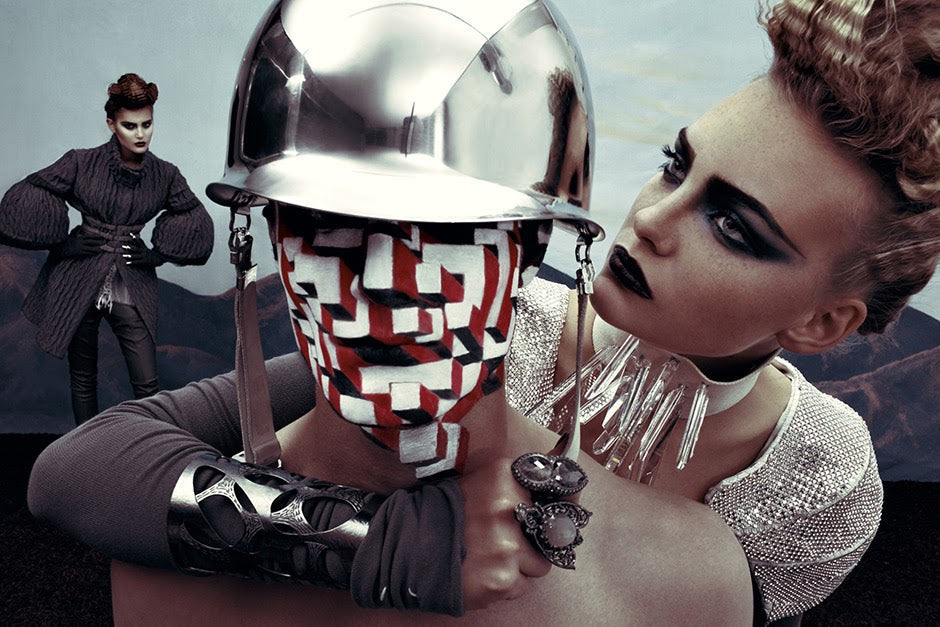by Redazione
Introduction
Fashion, in its most primordial essence, is not merely adornment but a semiosis of the flesh— a biological, psychological, and cultural language through which the human species negotiates its existential paradox: the tension between individual desire and collective survival. To frame fashion as a tool of attraction is to recognize its roots in Darwinian sexual selection, yet to confine it to such a reductionist schema is to ignore its metamorphosis into a hypercomplex system of symbolic exchange. Fashion operates as both a mirror and a catalyst of evolution, transcending its biological origins to become a theater where the drama of human becoming is performed. It is here, in the interplay of fabric and flesh, that we confront a profound philosophical inquiry: Does fashion signal genetic fitness, or has it become a simulacrum that destabilizes the very telos of perpetuation?
I. The Body as Bio-Semiotic Canvas
Long before the advent of couture, the body served as the first canvas for biological signaling. The iridescent plumage of birds-of-paradise, the antlered grandeur of stags — these are nature’s prototypes for the hermeneutics of attraction. In humans, however, the semiotic system diverges. Unlike fixed biological traits, fashion introduces mutable signs, allowing for the exaggeration, subversion, and recombination of signals. The peacock’s tail is static; the human donning a McQueen-esque feathered gown is engaged in a dynamic dialogue with both biology and culture.
This mutability reveals fashion’s dual role: it is simultaneously a testament to genetic fitness (e.g., the resource expenditure required for luxury) and a declaration of symbolic excess. The golden threads of a Dolce & Gabbana corset, for instance, no longer signify mere wealth but evoke a mythic archetype — the divine or regal body, transcending mortal constraints. Fashion thus becomes a dialectic between the biological imperative (“I am a viable mate”) and the existential aspiration (“I am more than a organism”).
II. The Memetic Evolution of Desire
If genes propagate through biological reproduction, fashion propagates through memetic selection — the replication of cultural symbols. Yet these memes are not arbitrary; they are tethered to primal codes. The hourglass silhouette, the elongation of limbs via stilettos, the amplification of shoulders in power suits — all distort the body to echo evolutionary triggers: fertility, strength, status. Even avant-garde deconstructions (e.g., Margiela’s disassembled tailoring) operate as meta-commentaries on these codes, exposing the artifice beneath the instinct.
Herein lies fashion’s existential gamble: by abstracting biological signals into aesthetic metaphors, it risks severing the link between signifier and signified. The latex “second skin” of a Mugler ensemble may mimic the sheen of health, while requiring no actual vitality from the wearer. Fashion, in this sense, becomes a Baudrillardian hyperreality — a simulation of fitness that threatens to render the original Darwinian logic obsolete. Yet this very abstraction may represent an evolutionary leap: the transition from survival of the fittest to survival through fiction.
III. The Thanatopic Paradox: Fashion as Death-Defying Ritual
Georges Bataille posited that eroticism is a revolt against the discontinuous self, a fleeting merger with the continuity of life. Fashion, as erotic ritual, follows this logic. By adorning the mortal body in ephemeral splendor — think of Schiaparelli’s gilded vertebrae or Viktor & Rolf’s exploding tulle — it mocks entropy. Each garment is a votive offering to the future, a plea for legacy beyond genetic expiry. The runway becomes a liminal space where the individual’s mortality is both confessed (“I decay”) and defied (“But my image persists”).
This ritualistic function aligns with Freud’s death drive: the compulsion to return to inorganic stillness, but only after asserting one’s singularity. The peacock’s tail risks predation; the human’s sartorial extravagance risks ridicule or resource depletion. Both acts are “wasteful” in utilitarian terms, yet indispensable for attracting mates and commanding social capital. Fashion, then, is thanatopic — an embrace of life’s finitude through the audacity of display.
IV. The Posthuman Horizon: Signaling Beyond the Species
As technology destabilizes the human form, fashion’s role as a signaling mechanism expands into uncharted realms. Iris van Herpen’s biomechanical hybrids or Auroboros’s bioluminescent algae dresses no longer address merely human mates but propose a dialogue with the *cosmos itself*. These designs evoke a post-Darwinian future where attraction is untethered from procreation, and signaling serves a new teleology: the perpetuation of consciousness rather than genes.
In this framework, fashion becomes a bridge between biological and synthetic evolution. A garment embedded with AI-responsive nanobots or CRISPR-modified organisms transforms the body into a cyborgian manifesto, signaling adaptability to hypothetical futures. The erotic charge shifts from fertility to futurability — the capacity to thrive in unknown worlds. Yet this raises a haunting question: If fashion ceases to signal to other humans, does it still serve the species, or does it inaugurate a new phase of existential alienation?
V. Conclusion: The Eternal Masquerade
Fashion’s deepest paradox is that it simultaneously affirms and negates the biological imperative. It began as a tool for survival, yet its zenith lies in transcending that purpose — turning the body into a cipher for ideas, fantasies, and existential rebellions. The sequined gown, the razor-sharp suit, the deconstructed uniform: these are not mere tools of attraction but hieroglyphs in an ongoing dialogue between life’s urgency and death’s inevitability.
To dress is to participate in a ritual older than humanity itself, a game of seduction that predates consciousness. Yet in its highest form, fashion subverts the game, replacing Darwin’s “survival of the fittest” with a Nietzschean “will to power” — a desire not just to endure but to redefine what endurance means. In this masquerade, the species finds not just a means of perpetuation but a reason to persist: the promise that beauty, however fleeting, might outlast the flesh.
Thus, fashion is both our most ancient instinct and our most sophisticated lie — a testament to the fact that humans, unlike peacocks, do not merely seek to survive. We aspire to be remembered.

